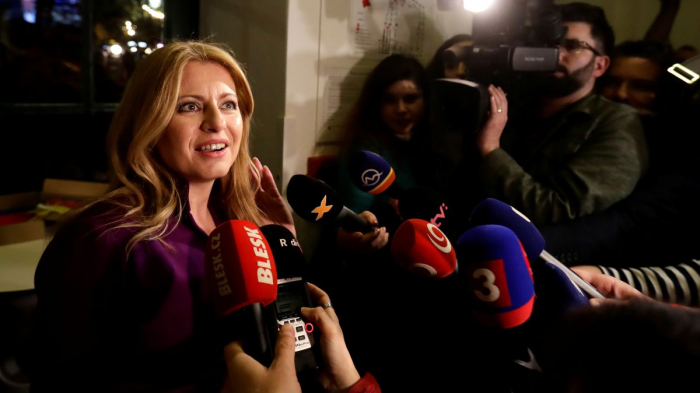A year ago, I visited Subotica, a small city on what was the 20th century border between Hungary and Serbia.
Like many cities in Southeastern Europe, Subotica has been governed over the centuries by Hungarian, Austrian, Turkish and Serbs, its diverse ethnic and religious communities living alongside each other amid uneasy transfers of power. Outside the Hungarian-Jewish Grand Synagogue, which fell into ruin after the genocide of Subotica's Jewish community in 1944, a memorial plaque now stands to "the memory of 4000 Jewish citizens with whom we lived and built Subotica." It is carved out in five languages, allowing the local Serb, Croat and Hungarian communities each to lend their own tongues to this multicultural expression of solidarity.
I thought of Subotica this week when I watched Zuzana Caputova, a lawyer and anti-corruption campaigner, claim victory in the presidential election of another eastern European country, Slovakia. After winning the election, Caputova thanked voters in five languages -- Slovak, Hungarian, Roma, Czech and Rusyn -- as she warned against populist nationalism. (Rusyn is an East Slavic language, similar to Ukrainian, sometimes referred to as Ruthene or Ruthenian.)
Caputova, the first woman to hold the presidency in Slovakia, already has been hailed in the West as a liberal heroine, though some observers suggest those prospects are too heavy. But unless you've visited Eastern European cities like Subotica, it's hard to understand how central the politics of language still is in nations like Serbia and Slovakia -- and how much of a statement Caputova's polyglot politics, embodied in her multilingual note of thanks, makes against the rise of exclusionary nationalism in Eastern Europe. Embracing Slovakia's multiple languages is as potent an anti-nationalist statement as you can get from a new president.
History illustrates the depth of tension associated with the resurgent nationalist impulses against which Caputova made her statement. Before the First World War, the Austro-Hungarian Empire ruled over an enormous swath of Europe that now constitutes 13 modern states. That also meant at least 15 different language groups. It was a recipe for unrest.
But as far back as 1867, the Hapsburg rulers of the region recognized that a peaceful Eastern Europe could be only one in which minority language groups were guaranteed linguistic protections. The 1867 Constitution of Austria-Hungary -- known as the "Compromise"-- states: "All races of the empire have equal rights, and every race has an inviolable right to the preservation and use of its own nationality and language. The equality of all customary languages in school, office and public life, is recognized by the state. In those territories in which several races dwell, the public and educational institutions are to be so arranged that, without applying compulsion to learn a second country language, each of the races receives the necessary means of education in its own language."
Even the minutes of public meetings had to be taken in every language spoken by 20% or more the local deputies. Whatever the indignities of imperial rule from Vienna, the minority communities of the Austro-Hungarian Empire were able at least to sustain their own living languages with official support.
But all these German, Hungarian, Slovak, Czech, Croatian, Polish, Yiddish, Italian, Romani, Romanian, Rusyn, Serbian, Bosnian, Slovene, Ukrainian, Bulgarian and Bunjavec speakers -- the list goes on and subdivides, depending whom you ask -- weren't tidily clustered into easily divisible geographical areas. So, when Austria-Hungary found itself on the losing side of World War I and its territory started to be parceled out into new nations under the Treaties of Versailles and Trianon, the new Eastern European states weren't nearly as linguistically homogenous as their nationalist leaders sometimes liked to pretend.
Americans are most likely to remember how ethnic tensions in the 1990s lead to the breakup of the former Yugoslavia. But similar tensions between ethnic groups have continued to simmer in many areas of the region. Slovakia itself, the site of Zuzana Caputova's display of language politics, only broke away from Czechoslovakia in 1992 as the Slovak population asserted itself against the political dominance of what is now the Czech Republic. In 1991, Slovaks in the region lived as a 31% minority within the Czechoslovakian state, according to that year's census. Now they're an 80.7% majority within the new Slovakia. The question is whether they've learned to treat their own minority neighbors as well they wished to be treated when they were in the minority.
The election of a President willing to speak the language of all her citizens is a good sign. Caputova's success seems to have been compelled primarily by her anti-corruption drive, in a society sick of obligatory and daily graft. But she has reminded Europe that anti-establishment insurgents can be pluralists as much as they can be populists. Caputova fought off a fierce campaign by the international alt-right to demonize her. On YouTube, you can find plenty of anti-Semitic attack videos painting her as an agent of George Soros, the liberal philanthropist hatedby Eastern Europe's nationalists for his support of pluralist societies.
Cities like Subotica in other Eastern European nations also may lead the way. Serbia has had notorious problems with ethnic nationalism, but in the northern regions which border Hungary and Romania, polyglot societies are still thriving. The province of Vojvodina, which includes Subotica and has a 12% Hungarian-speaking population, uses six official languages. And as multilingual inscriptions at its biggest, emptiest synagogue make clear, a society at ease with its ethnic diversity is a society less likely to repeat the genocides of the past.
Kate Maltby writes about theatre, politics and culture.
Read the original article on CNN.
More about: Slovakia
















































